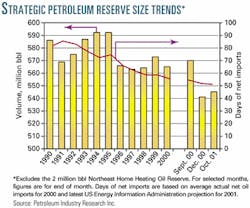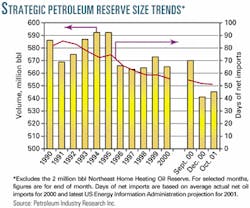SPR volumes reflect oil stocks trend
Before President George W. Bush announced last month that the US would fill the Strategic Petroleum Reserve with federal royalty oil from Gulf of Mexico fields over the next 2 years (OGJ Online, Nov. 13, 2001), researchers at Petroleum Industry Research Foundation Inc. had released a report urging the government to fill the SPR now while oil prices are low and "the risks of disruption are growing (OGJ Online Oct. 30, 2001)."
PIRINC said that, since 1990, the SPR has accounted for 35% of total US oil inventories. Both the SPR and private oil industry holdings are lower today than in the first half of the 1990s.
"Changes appear modest in absolute volumes but are substantial when measured against demand, and especially against imports," PIRINC said, "Inventories have fallen to about 77 days [of demand] from the equivalent of nearly 100 days in the early 1990s, a decline of 21%. Relative to net oil imports, coverage has fallen to about 145 days from 235, a decline of nearly 40%."
The chart summarizes trends in total US oil inventories since 1990 in terms of volume and of days of net oil imports. The steeper declines in days of demand coverage and net imports come about because demand this year is 1.7 million b/d, or 16%, higher than in 1990, while net imports are up 3.4 million b/d, or 50%.
Inventories are measured as annual or monthly averages, with the average of the year to date for 2001. Reductions are seen both in the amount of oil held by industry and that in the SPR. This year, total inventories have averaged 90 million bbl, or about 6%, below their average level over the 1990s, PIRINC said, and "lower than any year during that time except 2000.
PIRINC said the motivations behind the inventory reductions-and their consequences-are very different. The SPR, which is entirely discretionary, is meant for emergency use, while the oil industry holds inventory to meet operational needs-for use in pipelines and refineries for example-and to a certain extent, in response to signals regarding future vs. current prices. Because holding inventories is costly, however, the industry minimizes operational levels of inventories in periods of low profitability and does not hold inventories for discretionary purposes.
Most reduction in industry inventories occurred in the first half of the 1990s, PIRINC said, when "the return on investment for the US majors in domestic refining and marketing averaged about 2.5%." With restructuring, however, ROI improved in the second half of the 1990s but still averaged only 7.5%, and "most of the gains from restructuring appear to have been passed on to consumers."
Average reported marketing, energy, and other operating costs for the majors fell by 90¢/bbl from the first half of the 1990s to the second half, while net margins improved by a reported 38¢/bbl. Gains for consumers from restructuring have not come without a cost, the analysts said, in that "ellipsea leaner industry offers less of a cushion against the unexpected and leaves more of the immediate adjustment to unanticipated events to consumers."
There have been unexpectedly high levels of demand in the past 2 years as well as temporary supply problems. These produced short-lived surges in prices that reversed when additional oil supplies became available.
SPR refill
The SPR has a capacity of 700 million bbl at four salt dome storage sites on the US Gulf Coast. They currently hold 545 million bbl, equivalent to 50 days of imports under current demand. Repayment of the 30 million bbl sold in September of last year-and the interest on it-will bring the SPR to 590 million bbl.
Interior Sec. Gale Norton directed Deputy Sec. Steve Griles to work with the Minerals Management Service to implement the transfer of oil as quickly as possible.
In addition, the Department of the Interior has twice added royalty in-kind reserves to the storage volumes. In 1999 and 2000 MMS transferred 28 million bbl to the reserve, and the agency said it would begin taking 60,000 b/d of royalty in-kind in April, with the volume to grow to 130,000 b/d by October 2002, adding 108 million bbl of oil over the next several years.

